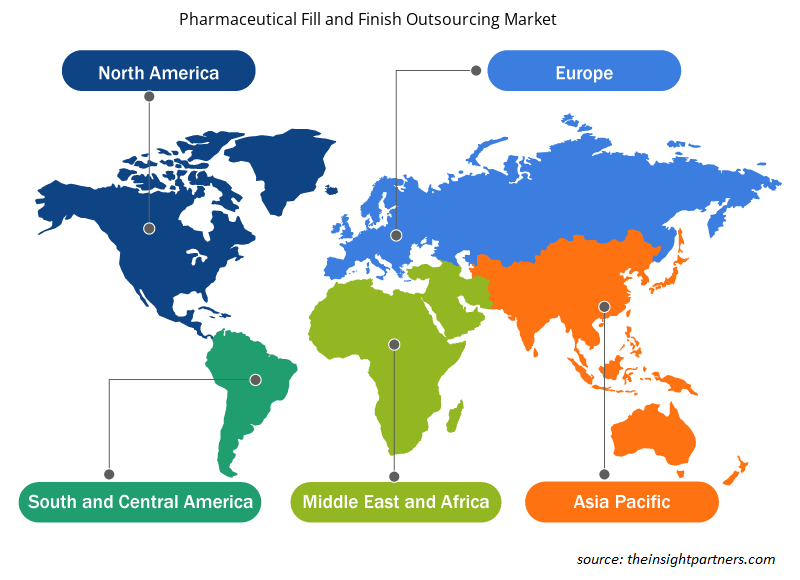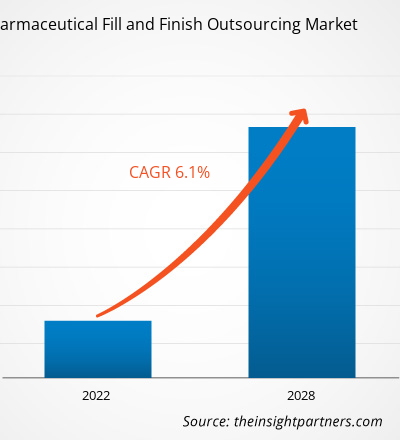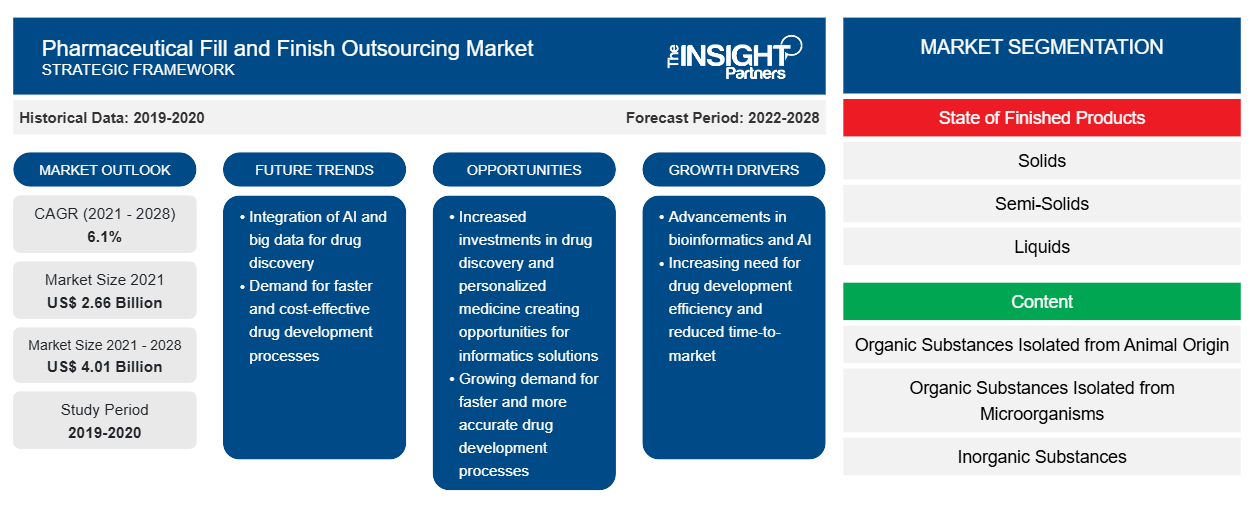Se proyecta que el mercado de subcontratación de llenado y acabado farmacéutico alcance los US$ 4.010,51 millones para 2028 desde los US$ 2.657,04 millones en 2021; se espera que registre una CAGR del 6,1% entre 2021 y 2028.
Se espera que la creciente demanda de las industrias farmacéutica y biofarmacéutica para satisfacer la demanda de la brecha de llenado/acabado impulse el crecimiento del mercado. Según el Centro de Evaluación e Investigación de Medicamentos (CDER) de la Administración de Alimentos y Medicamentos de los Estados Unidos (FDA), los productos biológicos representaron entre el 20% y el 29% de las aprobaciones de nuevas entidades moleculares (NME) en 2020. En 2019, las moléculas pequeñas representaron el 79% de todas las aprobaciones de NME, lo que representa 38 de las 48 NME aprobadas por la FDA y los productos biológicos representaron 10 de las 48 NME aprobadas o el 21% de todas las aprobaciones de NME. En 2018, las moléculas pequeñas representaron el 71% de las aprobaciones de NME y los productos biológicos el 29% de las aprobaciones de NME. Las empresas con capacidades internas a veces carecen de la capacidad para fabricar nuevos productos. Este factor respalda el crecimiento del mercado. Las capacidades especializadas, como la liofilización, el llenado de jeringas y cartuchos precargados o la creación de nuevos tratamientos terapéuticos, requieren técnicas de fabricación exclusivas que las empresas de tecnología biotecnológica consideran beneficiosas si las subcontratan a organizaciones de fabricación por contrato , ya que son rentables. Las empresas con capacidad interna de llenado y acabado aséptico subcontratan en promedio el 39 % de sus necesidades de llenado y acabado.
Es probable que América del Norte continúe su dominio en el mercado de subcontratación de llenado y acabado farmacéutico durante 2021-2028. Estados Unidos tiene la mayor participación del mercado en América del Norte y se espera que continúe esta tendencia durante el período de pronóstico. Los avances en automatización, como la robótica, han sido una de las áreas de progreso para las operaciones de llenado y acabado de Estados Unidos. Esto reduce principalmente el riesgo de contaminación en gran medida, lo que ayuda al crecimiento regional. La integración general de la cadena de suministro que reduce las interacciones humanas está impulsando el crecimiento del mercado de subcontratación de llenado y acabado farmacéutico. Por ejemplo, ABL adoptó la automatización en sus operaciones de llenado y acabado en 2017. La empresa completó una expansión de las operaciones de llenado y acabado aséptico en su planta de biofabricación GMP en Rockville, Maryland. La empresa instaló un sistema de llenado de viales completamente automatizado. Se espera que estos factores ayuden al crecimiento del mercado general de subcontratación de llenado y acabado farmacéutico.
Personalice este informe según sus necesidades
Obtendrá personalización en cualquier informe, sin cargo, incluidas partes de este informe o análisis a nivel de país, paquete de datos de Excel, así como también grandes ofertas y descuentos para empresas emergentes y universidades.
-
Obtenga las principales tendencias clave del mercado de este informe.Esta muestra GRATUITA incluirá análisis de datos, desde tendencias del mercado hasta estimaciones y pronósticos.
Perspectivas del mercado
Aumento de la demanda de productos biológicos
Se espera que la creciente cartera de medicamentos biológicos y la creciente preferencia por dichas intervenciones terapéuticas impulsen la demanda de subcontratación de llenado y acabado farmacéutico durante el período de pronóstico. Aproximadamente el 60% de los servicios de llenado y acabado involucran el envasado a escala clínica y comercial de vacunas contra la COVID-19. La expansión de las instalaciones es uno de los factores críticos que las empresas biofarmacéuticas están considerando durante la pandemia. Las empresas biofarmacéuticas se enfrentan a problemas como los cambios mencionados anteriormente y las limitaciones presupuestarias. La subcontratación es necesaria para superar estos problemas y satisfacer las demandas de productos biológicos. Se espera que la subcontratación de productos biofarmacéuticos de las organizaciones de fabricación por contrato impulse la industria de subcontratación de llenado y acabado farmacéutico durante los próximos siete años. Aproximadamente el 90% de la capacidad de llenado y acabado instalada pertenece a participantes del mercado con capacidades de producción a escala comercial. Más del 85% de la capacidad de llenado y acabado disponible pertenece a empresas de gran escala.
Información basada en el estado de los productos terminados
Según el estado de los productos terminados, el mercado de subcontratación de llenado y acabado farmacéutico se segmenta en sólidos, semisólidos y líquidos. El segmento de líquidos capturó la mayor participación en 2021 y se espera que continúe una tendencia similar durante el período de pronóstico. Se espera que la creciente demanda de jeringas y viales precargados en las industrias de jeringas de plástico impulse la demanda de subcontratación de llenado y acabado farmacéutico. La demanda de aplicaciones de viales en liofilización está impulsando el crecimiento del mercado de servicios de llenado y acabado. Además, el creciente número de nuevos participantes en la fabricación global de productos biológicos da como resultado el aumento de las actividades de subcontratación. Se anticipa que este factor ayudará al mercado global de subcontratación de llenado y acabado farmacéutico.
Según el contenido, el mercado de subcontratación de llenado y acabado farmacéutico se segmenta en sustancias orgánicas aisladas de microorganismos, sustancias orgánicas aisladas de animales y sustancias inorgánicas. El segmento de sustancias orgánicas aisladas de microorganismos tiene una participación de mercado considerable y se proyecta que continuará con una tendencia similar durante el período de pronóstico. Los avances en la subcontratación de llenado y acabado farmacéutico han permitido la implementación exitosa de la reducción de los riesgos de contaminación en la cadena de suministro. Esta integración de extremo a extremo ha ayudado con éxito a la demanda de sustancias orgánicas aisladas de microorganismos, lo que ha ayudado a la demanda de subcontratación de llenado y acabado farmacéutico.
Las empresas que operan en el mercado de subcontratación de llenado y acabado farmacéutico adoptan la estrategia de innovación de productos para satisfacer las cambiantes demandas de los clientes en todo el mundo, lo que también les permite mantener su marca en el mercado global.
Perspectivas regionales del mercado de subcontratación de llenado y acabado farmacéutico
Los analistas de Insight Partners explicaron en detalle las tendencias y los factores regionales que influyen en el mercado de subcontratación de llenado y acabado farmacéutico durante el período de pronóstico. Esta sección también analiza los segmentos y la geografía del mercado de subcontratación de llenado y acabado farmacéutico en América del Norte, Europa, Asia Pacífico, Oriente Medio y África, y América del Sur y Central.

- Obtenga datos regionales específicos para el mercado de subcontratación de llenado y acabado farmacéutico
Alcance del informe de mercado de subcontratación de llenado y acabado farmacéutico
| Atributo del informe | Detalles |
|---|---|
| Tamaño del mercado en 2021 | US$ 2.66 mil millones |
| Tamaño del mercado en 2028 | US$ 4.01 mil millones |
| CAGR global (2021-2028) | 6,1% |
| Datos históricos | 2019-2020 |
| Período de pronóstico | 2022-2028 |
| Segmentos cubiertos |
Por estado de los productos terminados
|
| Regiones y países cubiertos |
América del norte
|
| Líderes del mercado y perfiles de empresas clave |
|
Densidad de actores del mercado: comprensión de su impacto en la dinámica empresarial
El mercado de subcontratación de llenado y acabado farmacéutico está creciendo rápidamente, impulsado por la creciente demanda de los usuarios finales debido a factores como la evolución de las preferencias de los consumidores, los avances tecnológicos y una mayor conciencia de los beneficios del producto. A medida que aumenta la demanda, las empresas amplían sus ofertas, innovan para satisfacer las necesidades de los consumidores y aprovechan las tendencias emergentes, lo que impulsa aún más el crecimiento del mercado.
La densidad de actores del mercado se refiere a la distribución de las empresas o firmas que operan dentro de un mercado o industria en particular. Indica cuántos competidores (actores del mercado) están presentes en un espacio de mercado determinado en relación con su tamaño o valor total de mercado.
Las principales empresas que operan en el mercado de subcontratación de llenado y acabado farmacéutico son:
- Abad
- Industrias farmacéuticas Teva Ltd.
- Laboratorios del Dr. Reddy
- Industrias farmacéuticas Sun Ltd.
- Empresas Piramal Ltd.
Descargo de responsabilidad : Las empresas enumeradas anteriormente no están clasificadas en ningún orden particular.

- Obtenga una descripción general de los principales actores clave del mercado de subcontratación de llenado y acabado farmacéutico
Mercado de subcontratación de llenado y acabado de productos farmacéuticos
El mercado global de outsourcing de llenado y acabado farmacéutico está segmentado en función del estado de los productos terminados y el contenido. Según el estado de los productos terminados, el mercado se clasifica en líquidos, sólidos y semisólidos. Por contenido, el mercado se segmenta en sustancias orgánicas aisladas de microorganismos, sustancias orgánicas aisladas de animales y sustancias inorgánicas. Según las regiones, el mercado global de outsourcing de llenado y acabado farmacéutico está segmentado en América del Norte, Europa, Asia Pacífico, América del Sur y Central y Oriente Medio y África. El mercado de América del Norte está segmentado en Estados Unidos, Canadá y México. El mercado de Europa está segmentado en Francia, Alemania, Italia, España, Reino Unido y el resto de Europa. Asia Pacífico está segmentado en China, Japón, Corea del Sur, India, Australia y el resto de Asia Pacífico. Oriente Medio y África está segmentado en Sudáfrica, Arabia Saudita, Emiratos Árabes Unidos y el resto de Oriente Medio y África. América del Sur y Central está bifurcada en Brasil, Argentina y el resto de América del Sur y Central.
Las empresas que operan en el mercado son Abbott, TEVA PHARMACEUTICAL INDUSTRIES LTD, Dr. Reddy's Laboratories, Sun Pharmaceutical Industries Ltd, Piramal Enterprises Ltd., MabPlex International Ltd, WOCKHARDT, Cytovance Biologics, Thermo Fisher Scientific Inc. (Patheon NV), Boehringer Ingelheim International GmbH, entre otras.
- Análisis histórico (2 años), año base, pronóstico (7 años) con CAGR
- Análisis PEST y FODA
- Tamaño del mercado, valor/volumen: global, regional y nacional
- Industria y panorama competitivo
- Conjunto de datos de Excel
Informes recientes
Informes relacionados
Testimonios
Razón para comprar
- Toma de decisiones informada
- Comprensión de la dinámica del mercado
- Análisis competitivo
- Información sobre clientes
- Pronósticos del mercado
- Mitigación de riesgos
- Planificación estratégica
- Justificación de la inversión
- Identificación de mercados emergentes
- Mejora de las estrategias de marketing
- Impulso de la eficiencia operativa
- Alineación con las tendencias regulatorias























 Obtenga una muestra gratuita para - Mercado de subcontratación de llenado y acabado farmacéutico
Obtenga una muestra gratuita para - Mercado de subcontratación de llenado y acabado farmacéutico